Hi again,
I'm just reading an excellent book on the Me 262 by a certain Dan Sharp ;-)
It has some very interesting documents in the appendix, including one written by production specialist Otto Lange on on Me 262 production. (On request by the Allies, I guess.)
Lange (who according to Dan was an employee of Speer, not of Messerschmitt) confirms the bad situation with regard to "valuable skilled labour":
"The capacity available in Germany in the construction of jigs, tools and gauges was extremely overstretched due to the enormous demands of the entire armaments industry. This was further increased by the requirements for aircraft construction from March 1944. The unmet demand for skilled workers for this branch of industry in July 1944 was about 20,000, including about 4,000 for Messerschmitt."
That's the background when the Volksjäger idea is proposed to the aircraft manufacturers, threatening to syphon off skilled toolmakers, a critical resource which is in desperately short supply all over the industry, to setting up He 162 production. That a risky investment that will, even if the gamble works out, have a delayed pay-off, but an immediate negative impact on the rest of the industry regardless of the future success or failure of the Volksjäger.
So, I'd still maintain that Messerschmitt's opposition to the Volksjäger idea was well-justified, as I'm sure he was fully aware of the situation described by Otto Lange.
Despite this, I believe it probably was inevitable that the Volksjäger was put into production because at that time in the war, it was more important to create the illusion that something bold and energetic was done to win the war, than actually trying to win the war, as it was as good as lost anyway. That's a bit of the leitmotif of Schabel's "Die Illusion der Wunderwaffen", and I think it applies quite well to the He 162.
Regards,
Henning (HoHun)
[*]Generally, it is correct that the Luftwaffe needs a great number of jets. However, it won't be possible to provide a larger number of jets of a new design until spring or summer 1945 than the number that can be provided by ramping up production of the existing design. This is owed to the well-established industrial learning curve, on which the Me 262 has progressed quite a way, with about 700 examples produced by the time He 162 will start. The He 162 is an untested aircraft, and production initially will be difficult as all kinds of changes have to be introduced into series production to fix the inevitable teething troubles. According to experience, a new design requires about 7 times as much labour as the same type in normal mass production. Hasty development will increase this ratio even further. Just setting up production of a new type is a massive undertaking as well, and this will, unlike production itself, require the employment of a high proportion of valuable skilled labour - 2.5 million skilled labour hours. This will never pay off during the production life of the He 162.
[/LIST]
I'm just reading an excellent book on the Me 262 by a certain Dan Sharp ;-)
It has some very interesting documents in the appendix, including one written by production specialist Otto Lange on on Me 262 production. (On request by the Allies, I guess.)
Lange (who according to Dan was an employee of Speer, not of Messerschmitt) confirms the bad situation with regard to "valuable skilled labour":
"The capacity available in Germany in the construction of jigs, tools and gauges was extremely overstretched due to the enormous demands of the entire armaments industry. This was further increased by the requirements for aircraft construction from March 1944. The unmet demand for skilled workers for this branch of industry in July 1944 was about 20,000, including about 4,000 for Messerschmitt."
That's the background when the Volksjäger idea is proposed to the aircraft manufacturers, threatening to syphon off skilled toolmakers, a critical resource which is in desperately short supply all over the industry, to setting up He 162 production. That a risky investment that will, even if the gamble works out, have a delayed pay-off, but an immediate negative impact on the rest of the industry regardless of the future success or failure of the Volksjäger.
So, I'd still maintain that Messerschmitt's opposition to the Volksjäger idea was well-justified, as I'm sure he was fully aware of the situation described by Otto Lange.
Despite this, I believe it probably was inevitable that the Volksjäger was put into production because at that time in the war, it was more important to create the illusion that something bold and energetic was done to win the war, than actually trying to win the war, as it was as good as lost anyway. That's a bit of the leitmotif of Schabel's "Die Illusion der Wunderwaffen", and I think it applies quite well to the He 162.
Regards,
Henning (HoHun)



